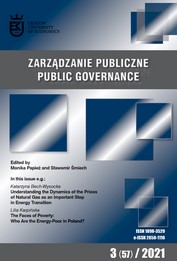Faces of Poverty: Who Are the Energy Poor in Poland?
Faces of Poverty: Who Are the Energy Poor in Poland?
Author(s): Lilia KarpinskaSubject(s): Energy and Environmental Studies, Environmental and Energy policy, Socio-Economic Research
Published by: Uniwersytet Ekonomiczny w Krakowie we współpracy z Wydawnictwem Naukowym Scholar
Keywords: energy poverty; profiles; hidden energy poverty; energy poverty ratio; subjective indicator; Poland;
Summary/Abstract: Objective: The author’s goal is to portray energy poor households in Poland based on several well-recognised and original indicators and some clustering techniques. In this study, I check whether the target population is identified correctly and I show possible directions in which the state energy poverty policy might evolve in this regard. Research Design & Methods: The ten-percent energy poverty measure, the ability-to-keep-home-warm, and the hiddenenergy-poverty measures are used to examine the profiles of the energy poor. My source of data is the energy consumption module of the Household Budget Survey collected by the Polish statistical office in 2018. The statistical techniques include multiple linear regression, lasso regression, partitioning around medoids procedure, and hierarchical clustering, among other things. Findings: All indicators produce different rates of energy poverty, but they are consistent in describing the energy poor groups. Two similar clusters are obtained. The first group is composed mostly of retired single women occupying blocks of flats. The second group is represented mainly by working men living in families with children in stand-alone houses in remote areas. Implications / Recommendations: Although politicians might choose an energy poverty measure which gives the convenient level of energy poverty incidence, the profile of the target population does not change much. The above implies that regardless of the approach to estimating energy poverty, the profiles obtained in this study should be considered as a target population for policy actions. Contribution / Value Added: Energy poverty in Poland is often linked to low-stack emissions coming from the residential sector. The owners of single-family houses are the main target of many state programmes aimed at improving the air quality in the country as well as fighting energy poverty. In this study, I show that there are at least two target groups. The results are robust with regard to energy-poverty measuring.
Journal: Zarządzanie Publiczne
- Issue Year: 2021
- Issue No: 57
- Page Range: 23-39
- Page Count: 17
- Language: English

